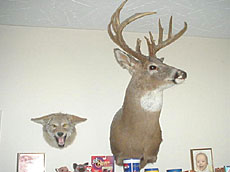|
"Hardly
a day goes by that Iím not talking to somebody about coyotes," says the
Lincoln native. In his home are photos of coyotes, statuettes of coyotes, books
about coyotes, and just about every coyote caller that was ever made. He has
published two articles about coyote calling in sport and wildlife magazines and
is being encouraged to write more. And this "self-taught coyote
professional" spends a good part of his time hunting coyotes, both because
he likes to study and videotape them and because in his business of nuisance
wildlife control he sometimes has to get rid of animals that are killing farmersí
livestock.
Lesís
obsession with coyotes started in 1984, when he went to the National Trapping
Convention, which met that year in Peoria. "Bill Austin of Rawlings,
Wyoming, a government predator control agent, gave a seminar on coyote calling,
and I got hooked," Les says.

[Les's license plate on the truck he uses for his nuisance animal
control business, is "I howl."]
He
had been involved in hunting and trapping since he was a boy. "My
grandfather, John B. Wood (known as J.B.), was a trapper and ran his own
business as a fur buyer in Lincoln for 15 years," Les remembers. "He
bought furs in the winter from local hunters and trappers. He would skin and
stretch the fur, and at the end of the season he would sell it to a New York fur
house.

"As
a boy, I would help my grandfather run his traplines. He mostly trapped farm
ditches for muskrat, mink and raccoon. Growing up around this lifestyle, I
became interested in trapping and hunting too. Each year I would get permission
from local farmers to trap on their property. In 1984 the fur market hit an
all-time high. Raccoon pelts were going for $30 to $40 each. A local trapper
could make good money during the season," he recalls.
But
in 1985, when the Russian economy took a nose dive, the bottom also fell out of
the fur market. That was because 90 percent of the fur harvested by Americans
was sold in Russia. Local trappers and fur buyers went out of business.

Before
long, Les saw the need for a new line of work. With urban expansion and the
increasing populations of animals (due in part to the reduced fur harvest),
conflicts between humans and animals increased. There were raccoons emptying
garbage cans, squirrels nesting in attics and chewing up woodwork and electric
wires, and coyotes killing farm stock. Sometimes the animals had to give.
[to
top of second column in this section]
|

Les
took a wildlife biology test and got a commercial trapping license
from the Illinois Department of Natural Resources (IDNR) in 1985.
Then he started Wood Wildlife Service, specializing in nuisance
animal control. Heís so busy these days he can hardly sit down for
a meal without having to get up and answer a phone call from a
potential customer. Often itís somebody with skunks in his barn,
begging Les to come out with a couple of live traps.

[Heads of a deer and a coyote taken by Les hang on
the living room wall]
Skunks
are the number one carrier of rabies, and when they are trapped,
state law says they have to be exterminated. Raccoons are the number
three carriers of rabies (bats come in second), and they also carry
the leptospirosis virus, which gives human beings a chronic disease
that cannot be cured. By law, raccoons must also be euthanized when
trapped. Les says there has been no rabies in Logan County for many
years.
In
the summer, Les gets many calls to trap animals with distemper,
which they can pass on to pets and other domestic animals. Diseased
animals must also be euthanized.
Others,
such as beaver, opossum, and squirrels, can be live trapped and
released far away from the site where they are caught. Les always
uses live traps, which do not injure the animals.

Farmers
want to get rid of coyotes because they kill livestock, especially
in the spring when young animals are born. They prey on lambs, baby
pigs and even newborn calves. At one Logan County farm, two coyotes
killed 18 lambs in one night, and at another they killed a newborn
calf before the mother cow could get to her feet and protect it. Les
sometimes traps and releases coyotes, but often farmers want them
permanently disposed of. Then he has to call them and shoot them.

Before
he can get rid of the coyotes, Les has to find them. Knowing the
habits of these animals helps him do that. It also got him hooked on
coyotes.
(To
be continued)
[Joan
Crabb]
|

